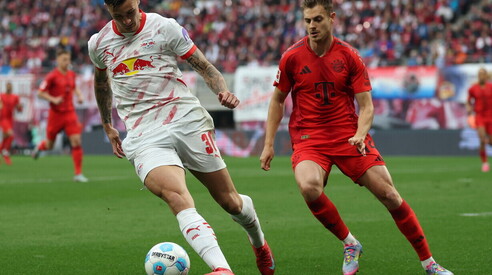The centre forward is back in fashion


Ansa photo
The Sports Newspaper
With Gyökeres, Ekitike, Sesko and Delap, the role of the central striker in the Premier League is changing.
On the same topic:
The complexity of football challenges the many pundits who, when at a loss for words, resort to "after all, football is simple." The complexity of football, which is also the name of the blog run by Filippo Galli, lies in its constant evolution, in its incomplete marriage between 11 players on the pitch and the coaching staff, especially when the 11 opposing players are the ones trying to crush it at the altar. It's a constant evolution, a chasing after each other that feels like a game of chess, with moves to close things down and others to prevent. Cycles, if you will. It happens everywhere, and in other sports too, it happens in the Premier League , which, thanks to the presence of some big-name coaches, is one of the most important tactical laboratories. And where attacking models based on movement were often sought, whether based on constantly occupying the famous five corridors or rapidly conquering midfield by attracting pressure and then quickly bypassing it, some teams are now moving in a different direction, simply because when countermeasures arrive, they have to react immediately.
Last year, Manchester City, especially after Rodri's injury, began playing more long balls with goalkeeper Ederson—a solution that, in both imagination and practice, has always been less associated with a Pep Guardiola team. The Brazilian ended up having the same number of assists as center forward Erling Haaland. The Catalan coach himself even discussed this at the end of 2024, in a press conference, emphasizing how modern football was made up of teams like Bournemouth, Brighton, Newcastle, and Liverpool, "which has always been the case, just like we were. Modern football is no longer positional like it used to be." One consequence of this was the rise in man-marking across the pitch, which prevented more frequent build-ups from the back and led to more long balls—a solution that City had already had to adopt much more often in the 2022-23 season, though obviously without sacrificing their core essence.
Indeed, City's summer signings, from Reijnders to Cherki, have reaffirmed their search for impactful players on the ground, to enrich a team that already boasted illustrious exponents in Doku and Savinho with one-on-one solutions. Many others, however, have strengthened their positions in a role that had partially fallen into disuse but is now making a comeback: that of central striker, interpreted in a modern and varied manner, given the different characteristics of each of the new arrivals, ranging from attacking midfielders to defensive midfielders: Arsenal with Viktor Gyökeres, Liverpool with Hugo Ekitike, Manchester United with Benjamin Sesko, Chelsea with Liam Delap and, in a different sense, Joao Pedro, Leeds United with Lucas Nmecha and, at the last minute, Dominic Calvert-Lewin, and Burnley with Armando Broja. In addition to those who already had a man of physique and presence, such as Crystal Palace, Everton, Fulham, Newcastle United, although there would be some criticism about the latter, given that Alexander Isak, perhaps the perfect representative of the new type of centre-forward, is currently an exile, that Callum Wilson has left and that even before the Isak issue erupted the club had tried with Ekitike to partner him with the Swede.
Liverpool, among other things, had to act in a semi-emergency situation due to the tragic death of Diogo Jota, but they were actually considering improvements, due to dissatisfaction with Darwin Nuñez's inconsistent performance and Luis Díaz's ambition to leave, as he was eventually allowed to do. In most matches, Díaz, a quick winger with a good run on the ball, was the starting center forward, alternating with Diogo Jota, due to team needs and his relentless pressing nature. Arne Slot's Liverpool side relies more on possession and run-making, but after last year's success, they've sought to intensify their attacking effectiveness with the attacking midfield skills of Julian Wirtz and, indeed, the versatility of Ekitike, who has the physique of a centre-forward, albeit taller than he is broad, but also has the remarkable ability to run wide and run with the ball looking for a pass, as evidenced by the statistic, reported by The Athletic, which places him fifth in Europe for 2024-25 in total expected goals + assists, an important measure of offensive contribution. A potential improvement in many respects compared to Nuñez, just as Gyökeres' arrival at Arsenal could be the turning point for Mikel Arteta's team, in an imperfect parallel with Haaland's arrival at City in the summer of 2022: because the Norwegian arrived to bring a new dimension to a good team accustomed to winning everything, while the Swede must make a qualitative leap in a group that is often equally good, but incapable of reaching the finish line, indeed often impalpable at the most crucial moment.
The powerful goal, the tenacious goal, the physical goal, the... ugly goal, the goal of presence in the box, just as Guardiola wanted from Haaland, crowning team moves aimed at creating the best conditions for everyone, as demonstrated by the Gunners' strengthening in midfield with Zubimendi and Norgaard. Constant evolution to respond to defensive progress and implement a forward run: because to face powerful, mobile strikers capable of winning aerial duels, opponents might in turn be forced to raise their defensive physicality and vary their approach. After all, Liverpool's first turning point in the 2024-25 season came precisely in defense: after central defender Jarrell Quansah repeatedly lost aerial clashes against Delap in his season debut away to Ipswich Town, Slot replaced him at half-time with Ibrahima Konaté, who has remained a regular starter since. Action, and reaction.
More on these topics:
ilmanifesto





